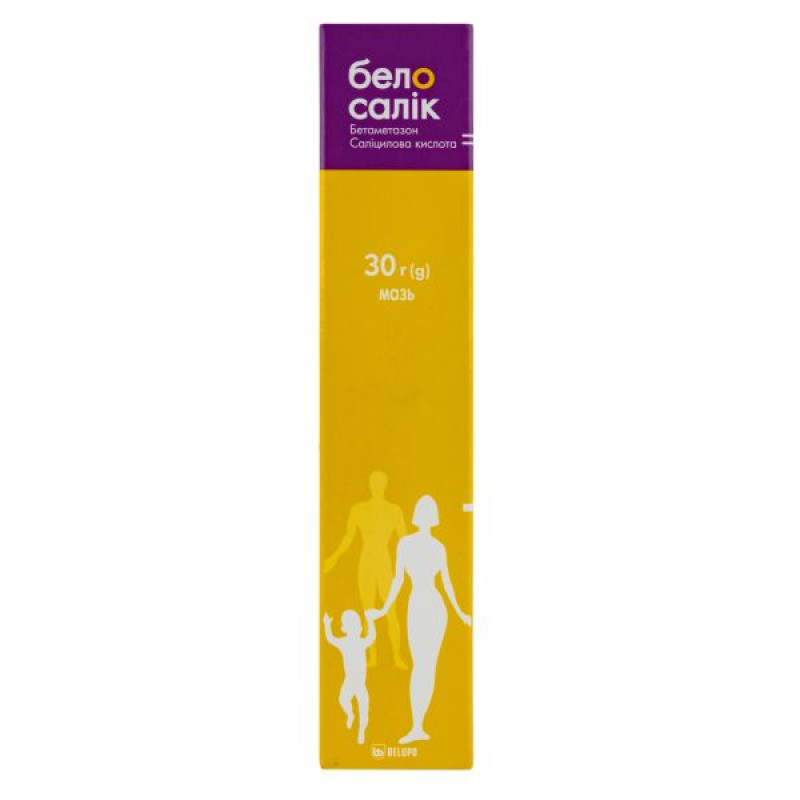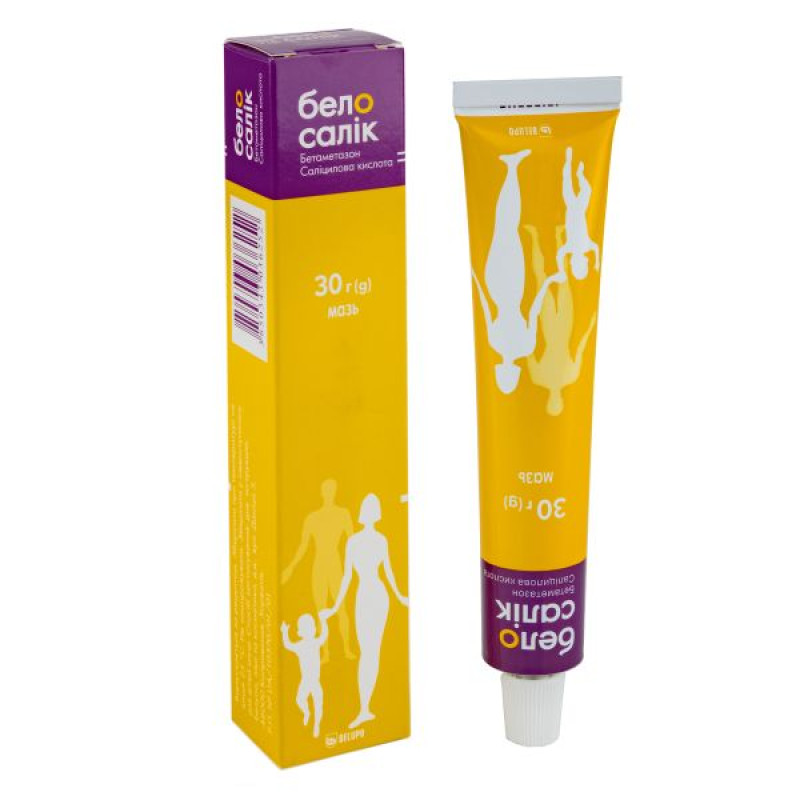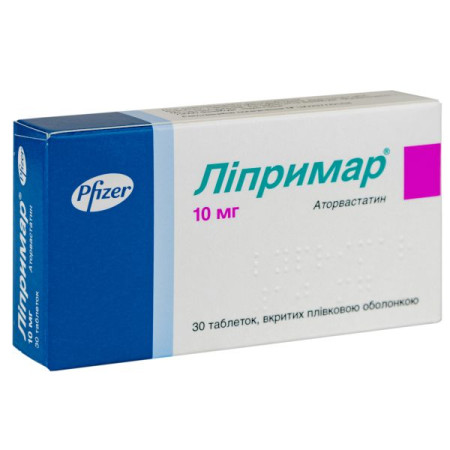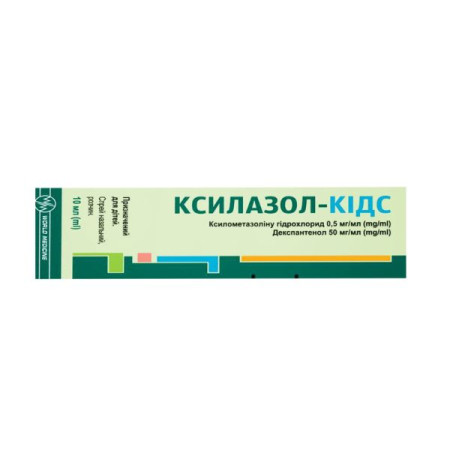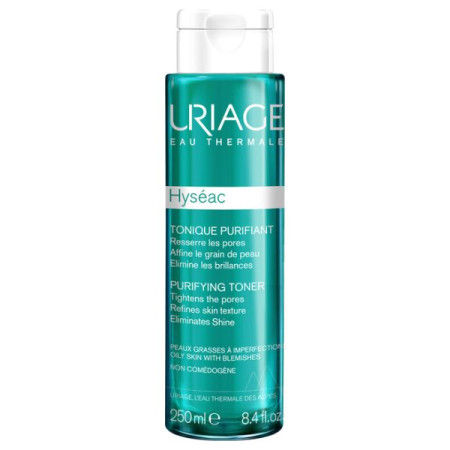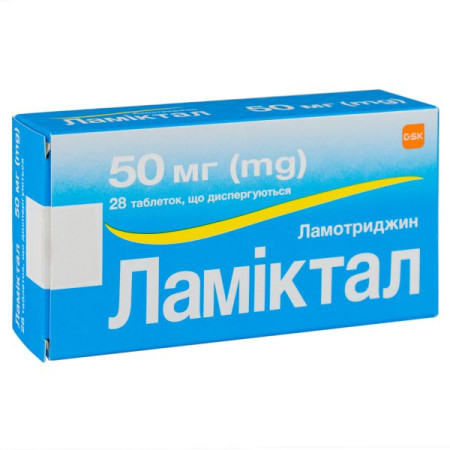Belosalik ointment tube 30 g
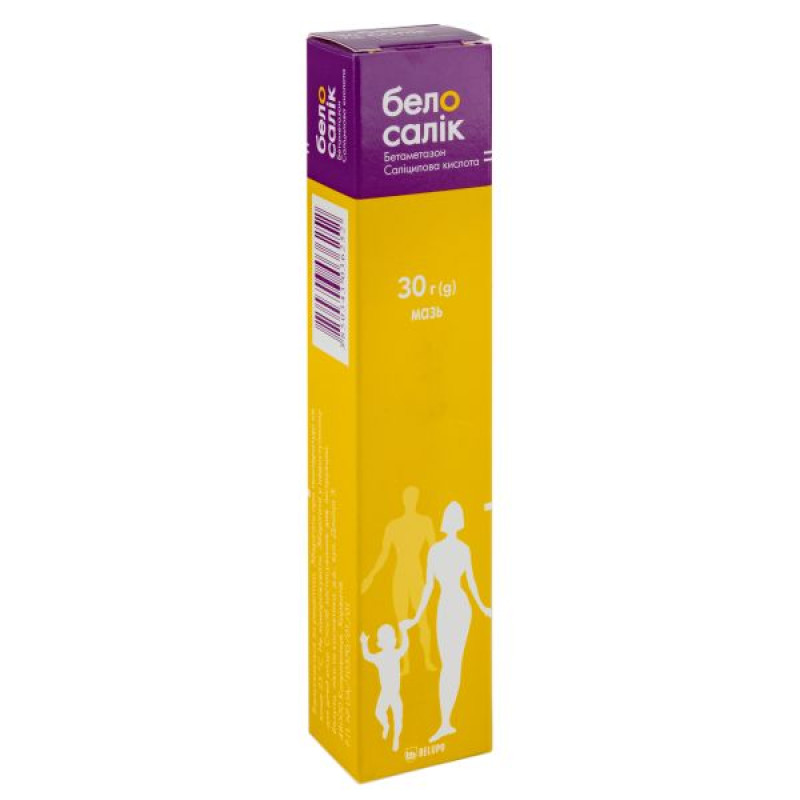
Instructions Belosalik ointment tube 30 g
Composition
active ingredients: betamethasone, salicylic acid;
1 g of ointment contains 0.5 mg of betamethasone in the form of dipropionate, 30 mg of salicylic acid; excipients: mineral oil, white soft paraffin.
Dosage form
Ointment.
Main physicochemical properties: white translucent homogeneous ointment.
Pharmacotherapeutic group
Corticosteroids for use in dermatology. Corticosteroids in combination with other drugs. ATX code D07X C01.
Pharmacological properties
Pharmacodynamics
Betamethasone dipropionate is a synthetic fluorinated corticosteroid that has anti-inflammatory, antipruritic, and vasoconstrictive effects. Salicylic acid has a keratolytic effect when applied topically.
Pharmacokinetics
Absorption of betamethasone dipropionate by the body is possible mainly after long-term treatment on a large surface of the skin.
Indication
For the topical treatment of dermatoses sensitive to corticosteroids, such as chronic, erythematous or hyperkeratotic psoriasis and other dermatoses of an erythematous-squamous nature, such as seborrheic dermatitis (eczema), dry eczema in the desquamative phase, lichenification.
Contraindication
Hypersensitivity to betamethasone, salicylic acid or any of the excipients of the drug. As well as rosacea, acne, widespread plaque psoriasis, perianal and genital itching, diaper dermatitis, perioral dermatitis, rosacea, skin manifestations of syphilis, skin tuberculosis, other bacterial and fungal skin infections without adequate antibacterial and antifungal therapy, molluscum contagiosum, dermatomycoses, skin reactions after vaccination, varicose veins, viral infections (e.g. herpes simplex, shingles, chickenpox). Should not be used under occlusive dressings.
Interaction with other medicinal products and other types of interactions
There are no known cases of interactions with other medicines.
Topical application of salicylic acid should not be combined with oral use of preparations containing acetylsalicylic acid and other nonsteroidal anti-inflammatory drugs. Do not use with benzoyl peroxide and topical retinoids.
Salicylic acid may increase the skin permeability of other topical medications and thereby increase their absorption into the body. In addition, salicylic acid may enhance the undesirable effects of methotrexate and the hypoglycemic effects of oral sulfonylurea antidiabetic drugs.
If you are using any other medications, you should definitely inform your doctor.
Application features
The drug is not intended for use in ophthalmology. Avoid contact with eyes, mucous membranes, wound surfaces and ulcers.
When used on facial skin, the duration of the course of therapy should be limited to 5 days.
If skin irritation or hypersensitivity occurs during use of the drug, treatment should be discontinued. In the presence of infection, appropriate therapy should be prescribed.
When dandruff or keratinization disappears, continue treatment with corticosteroids only.
Any side effects that occur with the use of systemic corticosteroids, including suppression of the function of the adrenal cortex, may also be observed with the local use of glucocorticosteroids, especially in children.
Systemic absorption of topically applied glucocorticosteroids or salicylic acid will be higher if treatment is carried out on large body surfaces or when occlusive dressings are used. Appropriate precautions should be taken in such cases, especially when treating children.
Long-term therapy with the drug should be avoided in all patients, regardless of age.
If excessive dryness or increased skin irritation develops, the use of the drug should be discontinued.
The function of the GHNS system is usually restored upon discontinuation of the drug. In some cases, withdrawal symptoms may develop, requiring the addition of a systemic corticosteroid.
When dandruff or keratinization disappears, continue treatment with corticosteroids only.
It is not recommended to use the drug under occlusive dressings.
If infection is present, antifungal or antibacterial agents should be prescribed as appropriate. If the desired effect does not occur quickly, corticosteroids should be discontinued until signs of infection resolve.
Appropriate precautions should be taken to prevent increased absorption when using the product on damaged areas, atrophied skin, large body surfaces, under occlusive dressings or in children (due to a higher body surface area/body weight ratio). When using on large body surfaces, the absorption of salicylic acid should also be taken into account.
Visual disturbances are possible with systemic and topical corticosteroids (including intranasal, inhaled, and intraocular use). If symptoms such as blurred vision or other visual disturbances occur, the patient should be evaluated by an ophthalmologist to evaluate possible causes of visual disturbances, which may include cataracts, glaucoma, or rare conditions such as central serous chorioretinopathy, which have been reported following the use of systemic and topical corticosteroids.
Topical corticosteroids may cause psoriasis for several reasons, including symptom relapse with subsequent development of tolerance, risk of pustular psoriasis, and local systemic toxicity due to decreased skin barrier function. Patients with impaired liver function are most susceptible to systemic effects. Close patient monitoring is necessary.
Topical corticosteroids may distort the clinical picture.
Relapse is possible if treatment is interrupted. The infection may worsen and healing may be delayed.
The drug should not be applied to mucous membranes or areas around the eyes due to the keratolytic effect of salicylic acid.
It is contraindicated to apply the drug to areas with atrophied skin.
Use during pregnancy or breastfeeding
Pregnancy.
Since the safety of topical corticosteroids in pregnant women has not been established, the drug should not be used in the first trimester of pregnancy. The appointment of corticosteroids in later stages of pregnancy is possible if the expected benefit to the expectant mother clearly outweighs the potential risk to the fetus. Drugs of this group are contraindicated in pregnant women in high doses and for a long time.
Breastfeeding period.
It is currently unknown whether topical corticosteroids can penetrate into breast milk due to systemic absorption, therefore, when deciding whether to discontinue breastfeeding or discontinue the drug, the need for the drug should be taken into account.
Ability to influence reaction speed when driving vehicles or other mechanisms
Usually the drug does not affect the reaction speed when driving or working with other mechanisms.
Method of administration and doses
Belosalik, ointment, should be used only externally, 2 times a day, by applying a thin layer to the affected surface and rubbing in lightly. The duration of treatment is usually limited to three weeks. The frequency and duration of use, other than the recommended one, can be established by the doctor, focusing on the severity of the disease. In mild cases, a single application during the day is sufficient. The maximum daily dose should be gradually reduced to the lowest possible, which would allow controlling the symptoms.
Children
There are no clinical data on the use of the drug in children, so it is undesirable to use it in patients of this age category.
Because children have a greater surface area to body weight ratio than adults, absorption of the drug is greater. Therefore, children are more susceptible to hypothalamic-pituitary-adrenal (HPA) axis suppression due to corticosteroid suppression and the development of exogenous corticosteroid effects.
In children receiving topical corticosteroids, adrenal suppression, Cushing's syndrome, growth retardation, insufficient weight gain, and increased intracranial pressure have been reported.
Manifestations of adrenal cortex suppression: low plasma cortisol levels and no response to the adrenal stimulation test with adrenocorticotropic hormone (ACTH) drugs. Increased intracranial pressure is manifested by fontanelle protrusion, headache, and bilateral optic disc edema.
Because corticosteroids may affect growth hormone production in children, their weight and height should be monitored.
Overdose
With prolonged or excessive use of topical glucocorticosteroids, suppression of pituitary-adrenal function with the development of secondary adrenal insufficiency and the appearance of symptoms of hypercorticism, including Cushing's disease, is possible. Excessive or prolonged use of topical preparations containing salicylic acid may cause the appearance of symptoms of salicism.
When using large doses of the drug, the keratolytic effect and allergic reactions may increase.
Treatment. Administer appropriate symptomatic therapy. Symptoms of acute hypercorticism are usually reversible. If necessary, electrolyte balance should be corrected. In case of chronic toxicity, gradual withdrawal of corticosteroids is recommended.
Treatment of salicism is symptomatic. Take measures to more quickly remove salicylates from the body. In case of overgrowth of resistant microorganisms, it is recommended to stop treatment with the drug and prescribe the necessary therapy. Use sodium bicarbonate orally to alkalize the urine and increase diuresis.
Side effects
The frequency is determined based on the following convention: very common (≥1/10), common (≥1/100, <1/10), uncommon (≥1/1000, ≤1/100), rare (≥1/10000, ≤1/1000), very rare (≥1/10000), frequency unknown (cannot be estimated from the available data).
Within each group, adverse reactions are presented in order of decreasing seriousness.
Infections and invasions.
Common: secondary infection.
From the skin and subcutaneous tissue.
Common: burning sensation, itching, irritation, dry skin, folliculitis, hypertrichosis, acneiform eruptions, telangiectasia, hypopigmentation, perioral dermatitis, allergic contact dermatitis, skin maceration, skin atrophy, striae and prickly heat.
From the endocrine system.
Rare: adrenal insufficiency (adrenal cortex suppression).
From the organs of vision.
Uncommon: visual disturbances, blurred vision.
The following adverse reactions may occur with the use of topical corticosteroids: tingling of the skin, skin thickening, skin cracking, feeling of warmth, flaky peeling of the skin, focal peeling of the skin, erythema.
When using the drug on a large area or under an occlusive dressing, especially for a long period, it is necessary to keep in mind the possibility of systemic effects of the drug.
The following adverse reactions may occur more frequently with the use of occlusive dressings: skin maceration, secondary infection, skin atrophy, striae and perspiration.
Hypersensitivity reactions are possible in individuals with individual intolerance to any component of the drug.
Blurred vision (see also section 4.4) has been reported with the use of corticosteroids.
Stretch marks and dilated blood vessels, mainly on the face, may result from prolonged continuous application of the drug.
Any adverse effects that occur with systemic use of glucocorticoids, including adrenal suppression, may also occur with their topical use.
With topical application of salicylic acid, the following skin changes may be observed: dryness, peeling, irritation, contact dermatitis, manifestations of allergic reactions (urticaria, itching), which require discontinuation of the drug.
With prolonged use, absorption of the drug into the general bloodstream and the development of side effects typical of salicylates are possible: tinnitus, dizziness, epigastric pain, nausea, vomiting, acidosis, rapid breathing.
Reporting of suspected adverse reactions
Reporting of suspected adverse reactions after the marketing authorisation of a medicinal product is of great importance. This allows for continuous monitoring of the benefit-risk balance of the medicinal product. Healthcare professionals should report any suspected adverse reactions via the national reporting system.
Expiration date
4 years.
Storage conditions
Store at a temperature not exceeding 25 ° C. Do not freeze.
Keep out of reach of children.
Packaging
30 g in a tube; 1 tube in a cardboard pack.
Vacation category
According to the recipe.
Producer
Belupo, medicines and cosmetics, etc.
Address
Danica Street 5, 48000 Koprivnica, Croatia.
There are no reviews for this product.
There are no reviews for this product, be the first to leave your review.
No questions about this product, be the first and ask your question.







